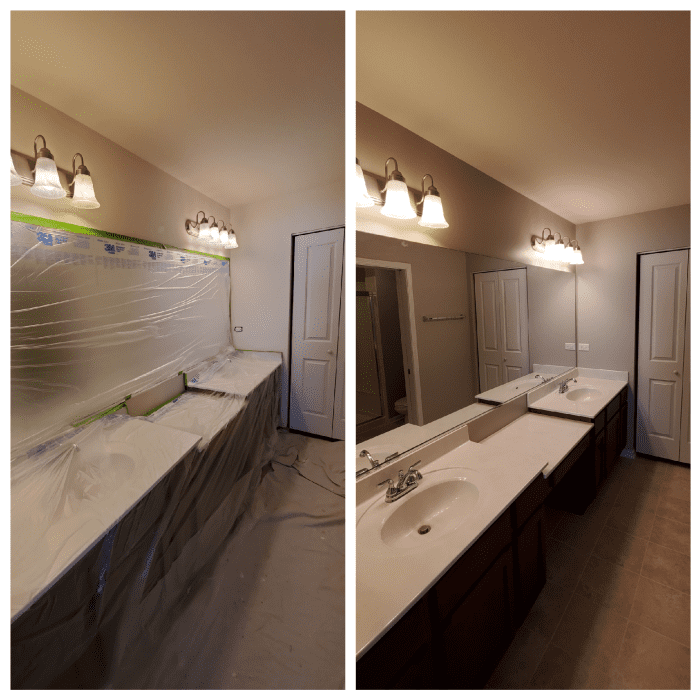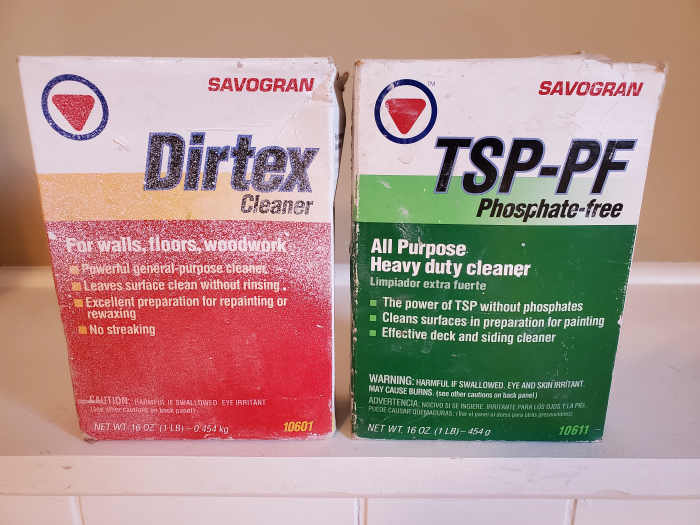How To Repaint Bathroom Walls
Matt is a professional painter and freelance writer, sharing his knowledge, house-painting tips, and product reviews.

Prepping and Painting a Bathroom
Like kitchens, bathrooms are more challenging to paint than other rooms with less obstacles to work around. Painting around the vanity, shower tile, light fixtures, or the wall behind the toilet, are some of the challenges you'll encounter, but before you start painting, take a close look at the walls first.
Bathroom walls get pretty nasty. The walls are exposed to frequent moisture and chemicals from soap and hairspray. Are there water streaks on the walls, or mildew? These are all things that shouldn't be ignored, or painted over without cleaning the walls first.
I've painted hundreds of bathrooms, and in this article, I go over how I prep and paint bathrooms from start to finish.
Painting supplies needed:
- 3M hand masker with masking film
- Painter's tape (preferably Frog tape)
- Step ladder
- 4-inch mini roller and handle
- 9-inch sleeve and handle
- 3-inch paint brush
- Patching compound
- Wall cleaner
- Drywall sanding sponge
- Drop cloths
- Screw driver

My favorite pre-paint cleaner for walls and wood.
Clean the Bathroom Walls
The walls in a heavily used bathroom take a lot of abuse and get really dirty over time. Wall stains from soap residue and water streaks won't go away by painting over them. The same applies to mold, or mildew, on the walls. Cleaning the drywall before painting is critical to avoiding problems.
Scrub the walls with a pre-paint cleaner. I try to avoid using heavy duty cleaners whenever possible. Use regular dish soap first, like Dawn, to clean your bathroom walls. In most cases, dish soap is enough to remove soap scum and water streaks on walls, but when a stronger cleaner is needed, I recommend Dirtex powder cleaner, or TSP. Both are excellent pre-paint cleaners. Scrub the walls good, especially around the toilet, sink, and shower area. Turn the ceiling fan on and let the walls dry overnight before you start painting.
Don't ignore mold and mildew. Vinegar works great for destroying the spores, followed by mold killing primer and paint. I wrote a full article on cleaning and removing mold from bathroom walls. The article goes in-depth on removing the hideous stains from walls and ceilings. Mold and mildew in a bathroom is usually caused by poor ventilation and infrequent cleaning. If the ceiling fan is too small, or not powerful enough, consider replacing it, otherwise the problem will eventually return.
Wipe down the baseboard. Bathroom baseboard, especially around the toilet, is always dirty. If you try to tape off dirty baseboard, the tape will fall off. Like the walls too, cleaning the baseboard is important if you're painting it. You can clean the baseboard with dish soap, or one of the pre-paint cleaners I mentioned.

Mask Off the Bathroom Before You Paint
Bathrooms have several key areas that need to be protected before you can paint the walls and ceiling without making a mess. Those areas include the vanity, sink, shower tile, tub, floor, toilet, and wall fixtures. Basically anything in the path of paint splatter should be protected.
Read More From Dengarden
Use a hand masker. The 3M hand masker is a must-have tool for paint prep. The masker has saved me so much time over the years, including hundreds of bathrooms I've painted and spray painting projects. It's very useful for masking bathrooms, kitchens, floors, windows and other painting projects. Use the matching 3M film rolls to quickly cover areas in your bathroom exposed to paint sprinkles. The rolls come in various lengths. I'll show you the best length for masking areas in your bathroom.
Cover the shower tile, vanity and mirror. With the hand masker, use the 3M film. The two best lengths for a bathroom are 99-inch and 48-inch. Use the 99-inch film and a roll of painter's tape to cover your shower door and tile and the vanity. Tape the plastic at the top and unravel it to cover the surface. For the mirror and flooring around the toilet and the toilet itself, use the 48-inch film.
Mask the floor around the toilet. Covering flooring around the toilet is easy, but don't use a drop cloth. Not only is it gross wrapping a nice clean drop cloth around a toilet, but the space is too small for the cloth to fit right. The easiest way to cover the floor around the toilet is with painter's tape and the 3M plastic I mentioned. Use the 48-inch film. Tape off the baseboard first and attach the plastic to it. Check out the picture below to see how I do it. Use a drop cloth to cover the main part of the bathroom floor.

Paint Your Bathroom
After you've patched the walls and done all of your prep work, you're ready to paint, but choose wisely. The paint you choose for your bathroom is important because some paints react poorly to humidity. Moisture can cause the thickeners and surfactants in the fresh paint to separate and form brown colored drips on the walls. This is known as surfactant leaching. I learned this the hard way many years ago when I painted a bathroom with Super Paint from Sherwin Williams. The paint doesn't like humidity. Make sure the paint you choose can be used in bathrooms.
The Best Bathroom Paint
The best way to avoid paint problems is by using dedicated bathroom paint, or just one that is formulated to tolerate humidity. The paint should also be washable. I've painted many bathrooms with Sherwin Williams Duration Home, including my own bathroom. The paint is very washable in the satin finish and resists surfactant leaching. Duration also contains anti-microbial agents to prevent mold and mildew.
Another good paint option is Regal Select from Benjamin Moore, or their Bath and Spa Aura paint. I've started using Regal Select on more of my painting projects and really like the paint. Like Duration, the paint is washable and contains anti-mildew additives to prevent mold.
If you've had mold and mildew problems in your bathroom, consider using mold killing primer and paint after thoroughly cleaning the surface and allowing it to dry.
Paint the Bathroom Walls and Ceiling
Always paint the ceiling first in any room you're painting. In a bathroom with excessive moisture, using a glossier paint on the ceiling, such as satin, or even semi-gloss, is best. Glossy paint is more water repellent and easier to maintain for cleaning purposes.
- Cut-in the ceiling corners. You don't have to cut-in precise paint lines when you're painting the walls after the ceiling. Fill the corners with paint. Another trick to avoid having to repeatedly climb up and down your step ladder when painting ceiling corners is to use an extendable paint brush on a pole.
- Roll the ceiling. The best paint roller for your bathroom is one that's 9-inches in length and lint-free. The Purdy White Dove rollers are a great option, or the Soft Woven rollers from Sherwin Williams, which are basically the same thing. Lint-free fabric rollers work great too. Make sure whatever you choose is lint-free. The best roller nap is 1/2-inch, or less. I like 1/2-inch nap because it lays on more paint without leaving heavy stippling texture.
- Paint the trim. Paint the trim after the ceiling and before the walls. You can paint the trim after the walls too, but it's easier to paint the trim first, tape it off, and paint the walls last. For bathroom trim, use waterborne alkyd trim enamel in a semi-gloss finish, or shinier. Bathroom baseboard gets really dirty and using glossier paint makes it easier to clean. Waterborne alkyd paint is a little more durable than regular acrylic. My favorites for trim in a bathroom and any other interior room is the Pro Industrial and Emerald urethane enamel from Sherwin Williams. I worked with Behr trim enamel on one project and wasn't a fan of it.
- Paint the walls last. Tape off the baseboard with painter's tape. To get neater paint lines and less leakage under the tape, consider using Frog tape. Carefully cut-in the bathroom walls after the ceiling's painted and roll the walls. Two coats of paint is best to increase the gloss of the paint for durability. To paint behind the toilet, remove the lid and use a 4-inch roller. If the gap between the toilet and the wall is too narrow, brush around it.
This content is accurate and true to the best of the author's knowledge and is not meant to substitute for formal and individualized advice from a qualified professional.
© 2021 Matt G.
Mark Bennis from Wellingborough, Northamptonshire, United Kingdom. on March 21, 2021:
A great hub and some sound advice.
Source: https://dengarden.com/home-improvement/Tips-for-Painting-a-Bathroom-Like-a-Pro







No comments:
Post a Comment